
 Olivia Møller
Freediver - Activist - Explorer
Olivia Møller
Freediver - Activist - Explorer

 Olivia Møller
Freediver - Activist - Explorer
Olivia Møller
Freediver - Activist - Explorer
Freediving enthusiasts are no strangers to the mesmerizing world beneath the waves. But what if we told you that there's a creature with unparalleled freediving abilities, effortlessly gliding through the water with grace and precision? Enter the North American river otter (Lontra canadensis). In this extensive exploration, we plunge into the depths of the underwater realm, unraveling the astonishing freediving capabilities that make these creatures true aquatic marvels.
The North American river otter's mastery extends beyond its exceptional freediving skills. It is intrinsically linked to the diverse aquatic environments it calls home. These semi-aquatic mammals have fine-tuned their lifestyles to thrive in a spectrum of habitats where the boundaries between land and water blur.
In freshwater realms, such as meandering rivers and tranquil lakes, North American river otters showcase their adaptability. Their streamlined bodies and powerful tails propel them effortlessly through the water, enabling them to navigate the intricate waterways with agility. The presence of abundant fish and aquatic prey in these freshwater habitats provides the otters with a rich source of sustenance, emphasizing the symbiotic relationship between their physical adaptations and the characteristics of their chosen environments.
Coastal areas further unveil the otters' habitat versatility. Here, where freshwater meets the saltwater of the ocean, these creatures exhibit a seamless transition between different aquatic ecosystems. Coastal zones offer a bounty of marine life, from fish to crustaceans, expanding the otters' menu and illustrating their ability to thrive in environments with varying salinity.
The significance of wetlands in the lives of North American river otters cannot be overstated. These ecosystems, characterized by a delicate balance of water and vegetation, serve as crucial nurseries for many aquatic species. Otters, with their webbed feet and keen swimming abilities, navigate these wetland habitats expertly, making use of the complex network of channels and ponds. The interplay between the otters and their surroundings showcases the intricate dance of nature, where adaptation to diverse habitats ensures the species' survival.
Moreover, the otters' choice of habitats is not solely based on resource availability. The proximity of suitable resting and breeding sites plays a pivotal role in their habitat selection. Well-protected shorelines, dense vegetation, and concealed burrows offer refuge and security for these creatures, underscoring the intricate balance they maintain between their terrestrial and aquatic lives.
Understanding the North American river otter's habitat mastery is a journey into the heart of ecological interconnectedness. It highlights the species' ability to adapt to a variety of aquatic environments, emphasizing the delicate dance between their physical adaptations and the intricacies of the landscapes they inhabit. From freshwater rivers to coastal realms and expansive wetlands, these habitats are not merely backdrops to the otters' aquatic exploits but integral stages upon which the drama of their lives unfolds.
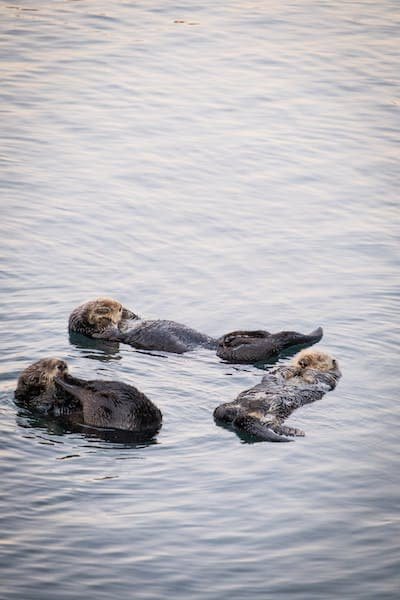
The North American river otter's physical form is a masterpiece of nature's ingenuity, finely tuned by the forces of evolution to navigate the aquatic realms with unparalleled grace. As we delve into the intricate details of their anatomy, we uncover a symphony of adaptations that orchestrate their aquatic prowess.
1. Streamlined Body: At first glance, the North American river otter's body appears tailor-made for aquatic life. Sleek and streamlined, it minimizes water resistance, allowing these creatures to glide effortlessly through the water. Their elongated bodies, tapered at both ends, reduce drag, facilitating swift and agile movements underwater. This streamlined design is a testament to the evolutionary imperative of efficiency in their aquatic pursuits.
2. Webbed Feet: The otter's webbed feet are a critical component of their aquatic toolkit. These specialized appendages function much like flippers, providing both thrust and maneuverability. The webbing between their toes enhances propulsion, enabling them to navigate water with precision. Whether coursing through the currents of rivers or darting beneath the surface of lakes, the webbed feet are essential for the otter's aquatic ballet.
3. Powerful Tail: The otter's tail serves as a dynamic rudder, contributing to its aquatic ballet. Muscular and tapered, the tail propels the otter forward with efficiency. It also aids in steering and stabilizing, allowing for quick turns and adjustments during underwater pursuits. The combination of a streamlined body and a powerful tail transforms the otter into a masterful navigator, effortlessly weaving through the intricate tapestry of its aquatic habitat.
4. Buoyant Fur: Beneath the surface, the otter's fur becomes an ingenious adaptation. Dense and water-resistant, it traps a layer of air against the otter's skin, providing buoyancy. This buoyancy not only aids in staying afloat but also reduces the energy expended during swimming. Moreover, the air-trapping fur acts as an insulator, keeping the otter warm in cold water—an essential feature for a species that thrives in diverse aquatic environments.
5. Vibrissae: The North American river otter's vibrissae, or whiskers, are sophisticated sensory tools. Sensitive to changes in water flow, pressure, and vibrations, these whiskers play a crucial role in navigating their underwater world. By utilizing their vibrissae, otters can detect prey, navigate through murky waters, and maintain spatial awareness—a testament to the multifaceted adaptations that contribute to their underwater success.
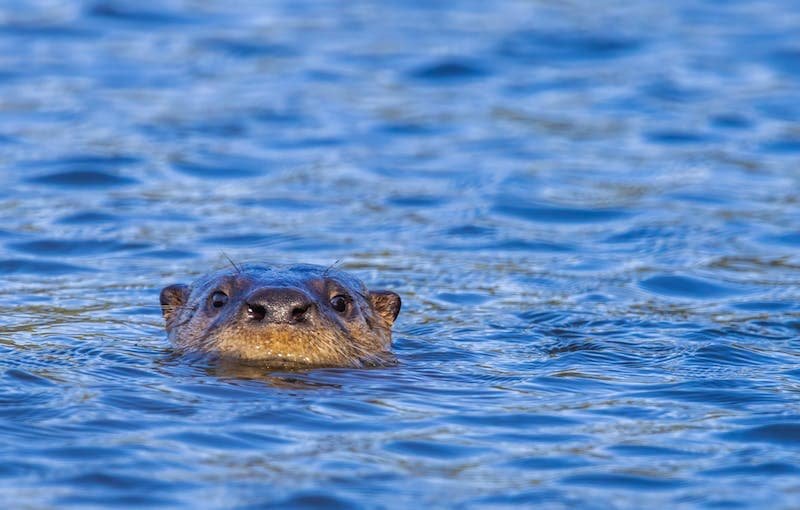
In the enchanting world of freediving, the North American river otter emerges as a maestro, conducting a symphony of underwater exploration with its exceptional breath-holding abilities. Behind this remarkable feat lies a fascinating tale of physiological adaptations and behavioral strategies that elevate the otter's underwater prowess to an art form.
1. Oxygen Efficiency: Central to the otter's breath-holding prowess is its remarkable efficiency in utilizing oxygen. As the otter prepares for a dive, its metabolic rate decreases, a process known as bradycardia. This physiological adjustment reduces the otter's heart rate, thereby conserving oxygen. The ability to slow down its metabolism allows the otter to extend the duration it can stay submerged, a critical adaptation for hunting and navigating underwater environments.
2. Enhanced Lung Capacity: The otter's respiratory system is finely tuned to support extended periods underwater. With lungs that can hold a significant volume of air, the otter maximizes its oxygen intake during each breath. This enhanced lung capacity serves as a biological reservoir, providing a vital oxygen supply during prolonged dives. The otter's ability to extract oxygen efficiently from the air ensures that it can embark on extended underwater forays without the immediate need to resurface.
3. Anaerobic Metabolism: As the otter ventures into deeper waters, where oxygen becomes scarcer, it taps into its anaerobic metabolism—a metabolic process that doesn't rely on oxygen. This adaptation allows the otter to continue its underwater activities even when oxygen levels are depleted, providing a temporary reprieve from the need to surface for air. While anaerobic metabolism is not a sustainable long-term solution, it provides the otter with added flexibility during its underwater excursions.
4. Strategic Breath Management: Beyond physiological adaptations, North American river otters exhibit an impressive degree of behavioral acumen when it comes to breath management. Before diving, an otter often takes a series of deep breaths, fully saturating its lungs with oxygen. This pre-dive ritual ensures that the otter begins its underwater journey with optimal oxygen levels, extending the duration it can spend beneath the surface.
5. Diving Techniques: Observing the otter's diving techniques unveils a choreography of skillful movements. The otter typically dives with a graceful arc, using its powerful tail to propel itself beneath the water's surface. Once submerged, the otter's streamlined body minimizes resistance, conserving energy and oxygen. These streamlined dives, coupled with strategic resurfacing intervals, enable the otter to explore its underwater domain with a finesse that captivates the imagination.
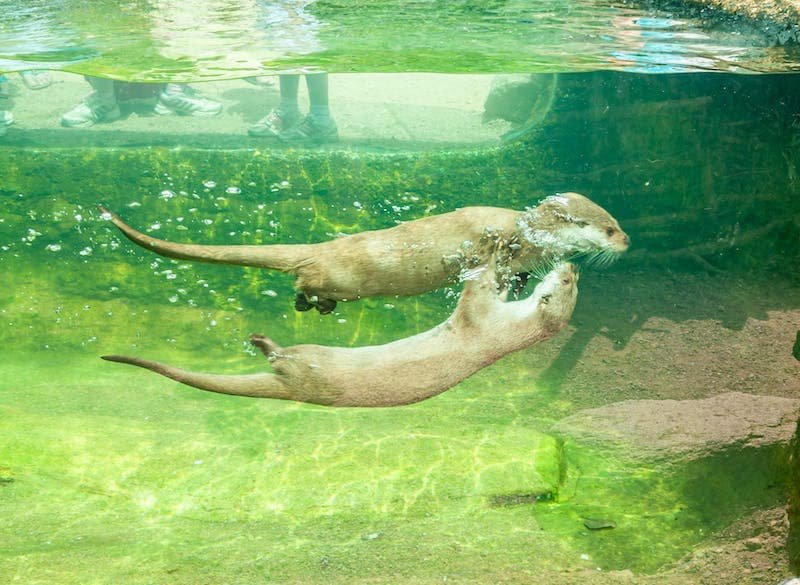
In the underwater theater of the North American river otter's world, the act of hunting is nothing short of a ballet—a mesmerizing display of precision, grace, and predatory prowess. As these aquatic maestros embark on their quest for sustenance, the depths become a stage for a performance that showcases the otter's exceptional adaptability and strategic approach to securing its underwater prey.
1. Stealthy Pursuits: The otter's hunting ballet often begins with a display of stealth. With a streamlined silhouette and keen eyes, it navigates through the water with minimal disturbance. The otter's ability to move almost silently beneath the surface allows it to approach unsuspecting prey without alerting them to its presence. This skill is a testament to the otter's understanding of the delicate balance between patience and opportunism.
2. Agile Maneuvers: As the otter homes in on its prey, its agile maneuvers come to the forefront. The powerful tail, webbed feet, and streamlined body work in harmony, enabling the otter to change direction swiftly and with remarkable precision. These acrobatic movements, akin to a ballet dancer gliding effortlessly across the stage, help the otter close the gap between itself and its quarry with an elegance that belies the intensity of the hunt.
3. Expert Use of Vibrissae: Central to the hunting ballet is the otter's expert use of its vibrissae—long, sensitive whiskers that detect the slightest movements and changes in water currents. Like a skilled dancer relying on finely-tuned senses, the otter utilizes its vibrissae to pinpoint the location of prey. This sensory awareness is crucial in the murky waters where visibility may be limited, allowing the otter to strike with precision.
4. Versatile Diet: The otter's hunting ballet is not confined to a single script. These adaptable predators have a versatile diet that includes fish, amphibians, and invertebrates. Each hunting expedition is a dynamic performance tailored to the specific challenges posed by the type of prey targeted. Whether deftly chasing a school of fish or defying gravity to capture aquatic invertebrates, the otter's hunting ballet is a testament to its ability to switch roles seamlessly within the aquatic ecosystem.
5. Playful Learning: In the midst of this balletic pursuit, the otter's hunting also serves a purpose beyond mere sustenance. Young otters engage in playful mimicry of hunting behaviors under the watchful eye of experienced adults. This play not only hones their skills for future endeavors but also fosters social bonds within otter communities. The hunting ballet, in this context, becomes a collaborative effort—a shared experience that strengthens familial ties.

The North American river otter's enchanting underwater world is not just a solitary realm of survival; it is also a canvas for social interactions that unfold in a silent ballet of communication. As these semi-aquatic creatures glide beneath the surface, their social freediving becomes a testament to the intricate relationships and bonds that tie otter communities together.
1. Synchronized Movements: One of the most captivating aspects of the otter's social freediving is the synchronized ballet of movements exhibited by family groups. As they navigate through their aquatic habitat, otters often engage in harmonious patterns, mirroring each other's motions with uncanny precision. This synchronized swimming is not merely a display of coordination; it serves as a means of strengthening social bonds within the group, fostering a sense of unity and cooperation.
2. Playful Interactions: Social freediving is not always about the serious business of survival; it also provides a stage for playful interactions. Otters, particularly the younger members of the community, engage in underwater games that resemble an aquatic ballet of joy. Twirls, spins, and somersaults become the language of play, fostering a sense of camaraderie and reinforcing social hierarchies within the otter family.
3. Vocalizations and Communication: While the underwater world may lack the resonance of sound, the otter community has developed alternative means of communication. Through subtle vocalizations and body language, otters convey messages to one another during their underwater forays. Whether it's a series of soft chirps to indicate contentment or more urgent sounds to signal danger, the otters' communication transcends the limitations of their aquatic environment.
4. Cooperative Hunting: Social freediving extends beyond mere companionship; it plays a crucial role in the cooperative efforts of hunting. Otters often work together to corral schools of fish or strategically position themselves to encircle prey. This coordinated approach maximizes the efficiency of their hunting endeavors, emphasizing the interconnectedness of the otter community's underwater activities.
5. Family Bonding: The underwater ballet of social freediving is, at its core, a reflection of familial bonds. Otters form close-knit family groups that engage in collective activities, including exploring, hunting, and resting. The underwater environment becomes a shared space where familial ties are reinforced, and the otters navigate the depths with a sense of togetherness that transcends the physical barriers of water.
6. Ritualized Grooming: As part of their social interactions, otters engage in ritualized grooming sessions beneath the water. This not only serves the practical purpose of maintaining their fur's waterproof quality but also reinforces social bonds. Grooming becomes a tactile language of affection and care, enhancing the sense of community among otters in their underwater habitat.
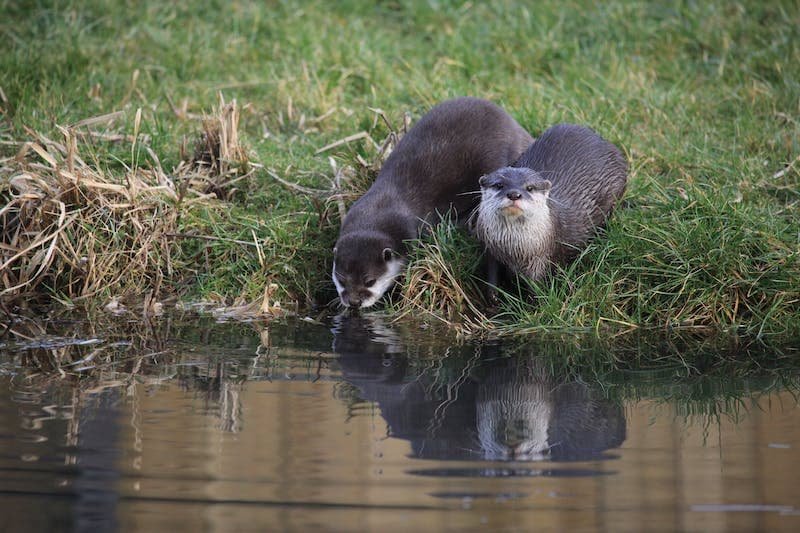
While the North American river otter's underwater ballet captivates observers, this species faces a set of conservation challenges that threaten the delicate harmony of its aquatic existence. As we peer into the waters where these creatures gracefully glide, it becomes evident that human activities and environmental changes pose significant threats, emphasizing the urgent need to safeguard the aquatic wonders inhabited by the North American river otter.
1. Habitat Degradation: One of the primary conservation challenges facing North American river otters is habitat degradation. As human populations expand and alter landscapes, the otters' habitats, including freshwater rivers, lakes, and coastal areas, are increasingly subjected to pollution, deforestation, and urbanization. These alterations disrupt the delicate balance of ecosystems, making it difficult for otters to find suitable territories for foraging, breeding, and resting.
2. Water Pollution: The health of otter habitats is further compromised by water pollution. Runoff from agricultural activities, industrial discharges, and other pollutants negatively impact water quality, affecting the availability of prey species and exposing otters to toxins. Contaminated water not only poses direct threats to otters but also disrupts the delicate aquatic food web on which they rely.
3. Human-Wildlife Conflict: As human activities encroach upon otter habitats, instances of human-wildlife conflict increase. River otters may face threats from encounters with boats, fishing gear, or even direct conflict with humans seeking to protect fisheries. These conflicts can result in injuries to otters, habitat displacement, and disruptions to their natural behaviors, posing a challenge to their overall well-being.
4. Climate Change Impacts: The specter of climate change looms over otter habitats. Rising temperatures, altered precipitation patterns, and changing water levels can influence the availability and distribution of prey species, affecting the otters' food sources. Additionally, shifts in climate can lead to changes in habitat suitability, potentially forcing otters to adapt to new conditions or face challenges in finding suitable environments.
5. Conservation Education and Awareness: Conservation challenges also include the need for public awareness and education. Many people may not fully grasp the importance of otters within their ecosystems or the consequences of human activities on otter populations. Raising awareness about the ecological significance of otters and promoting responsible human-wildlife interactions are crucial steps in fostering a collective commitment to conservation.
6. Conservation Legislation and Enforcement: To address the conservation challenges faced by North American river otters, robust legislation and effective enforcement mechanisms are essential. Implementing and enforcing laws that protect otter habitats, regulate fishing practices, and mitigate human-wildlife conflicts are critical components of ensuring the otters' continued well-being.
7. Habitat Restoration Efforts: Active habitat restoration initiatives are vital in mitigating the impacts of habitat degradation. Restoration projects that focus on preserving and rehabilitating key otter habitats, such as riparian zones and wetlands, contribute to the long-term sustainability of otter populations and the health of their ecosystems.
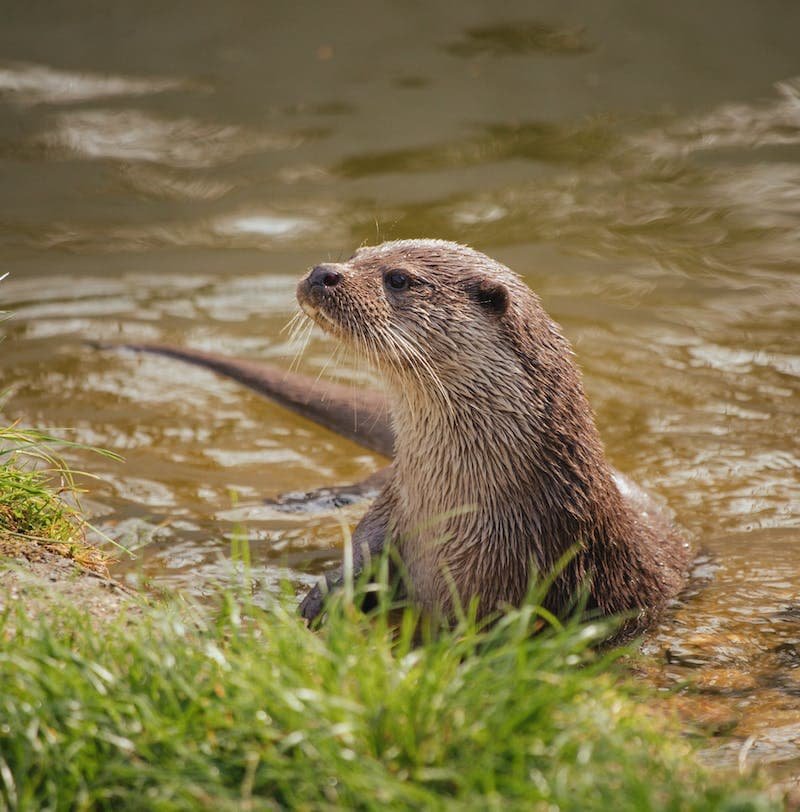
In the vast tapestry of freediving, the North American river otter emerges as a symbol of aquatic prowess. From their streamlined bodies to their unmatched breath-holding abilities, these creatures navigate the underwater world with unparalleled elegance. As we marvel at their freediving feats, let us also embrace the responsibility to protect their habitats and secure a future where the aquatic elegance of North American river otters continues to captivate generations to come.